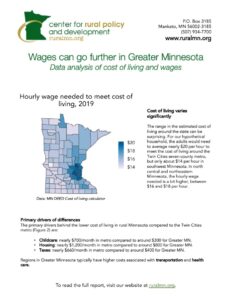An overview of Center for Rural Policy and Development’s cost of living and wage comparison tool.
June 2020
By Kelly Asche, Research Associate
For a printable version of this report, click here.
To see a 5 minute video summarising this research, click here.
On July 15th, 2020, we hosted a webinar, “The Case for Living Rural”, which provided an overview of this research. We were also joined by Ben Winchester, Rural Sociologist at the U of MN Extension | Center for Community Vitality to provide preliminary results on their newcomer survey.

Wages continue to be a primary talking point when discussing the economic competitiveness of regions across Minnesota. For years leaders in rural Minnesota have argued that it’s cheaper to live in rural areas, but so far most methods used to try to prove that have fallen short. Wages of various occupations are also often compared across Minnesota to determine where a person’s economic opportunity might be greatest.
But looking at cost of living and wages in isolation of each other paints only a partial picture. To get a more complete view, the Center for Rural Policy and Development has created a new tool to add to its online “Atlas[1]” (the cost of living tool is under Chapter 5 of our Atlas) that not only compares the cost of living across Minnesota, it also incorporates in wage data for various occupations and industries to determine “how far” those wages go in providing the basic needs of living in counties and regions across the state.
Our cost-of-living tool is meant to provide a more complete picture when comparing wages across Minnesota. This information can be used by economic development professionals to highlight the opportunities available in the county or region, while also pointing out where employers need to do better so their employees can meet their basic needs. The tool provides a starting point for these discussions without having to rely on anecdotal evidence.
In this report brief, we have provided an example of how to interpret the data from the online cost-of-living tool that also highlights the broad story that cost of living and wage data can tell us, that essentially, wages in Greater Minnesota are just as competitive with the Twin Cities, if not more so, in many occupations when considering the cost of living, particularly in southern and western Minnesota. However, if a larger percentage of the jobs are in occupations that typically pay low wages, the overall picture isn’t as rosy. This is particularly true for north central and northeast Minnesota, where tourism jobs are concentrated and where the cost of living is a bit higher compared to southern and western Minnesota.
The data
Our cost-of-living tool is based on data from the Minnesota Department of Employment and Economic Development, which has been publishing cost of living data since 2015. Their cost of living website allows the user to view cost of living for each county, economic development region, or planning region in Minnesota based on family situation (number of children, employment situation of parents, etc.). Costs are broken out into seven categories across each county.
- Food: Food costs are based on the USDA’s “Food plans: Cost of Food at Home” monthly estimates. There are four different types of food plans provided, and MN DEED uses the “moderate-cost plan” to calculate costs. These costs do not include the cost of restaurant meals.
- Housing: Costs are calculated using U.S. HUD’s Fair Market Rent Survey, which also includes the costs of utilities. It does not include the cost of telephone, cable, satellite, or internet service. DEED includes these costs under “other.”
- Health care: Premiums are calculated using the cost of MNSure plans across the state while out-of-pocket expenses are calculated using data from the Agency for Healthcare Research and Quality.
- Transportation: These figures attempt to represent the basic costs of owning and operating a car, including commuting to work, conducting necessary family and personal business, and getting to and from school and places of worship.
- Child care: These figures come directly from the Child Care Aware database, which publishes average rates for each county.
- Net taxes: This includes FICA payroll tax and federal and state income tax. It does not include property taxes.
- Other necessities: Captures the costs of apparel, personal care products and services, reading, education, and other miscellaneous items.[2]
The data are compiled from a truly comprehensive dataset of a dozen sources:
- Bureau of Labor Statistics, US Department of Labor
- Census Bureau, US Department of Commerce
- Center for Nutrition Policy and Promotion, US Department of Agriculture
- Agency for Healthcare Research and Quality, US Department of Health and Human Services
- US Department of Housing and Urban Development
- Internal Revenue Service, US Department of the Treasury
- Federal Highway Administration, US Department of Transportation
- Minnesota Department of Revenue
- Minnesota Office of the Revisor of Statutes
- Child Care Aware of Minnesota, Saint Paul, MN
- Council for Community and Economic Research, Arlington, VA, and
- National Bureau of Economic Research, Cambridge, MA.
To weave in the wage data, we added two data sources that allow us to compare wages against the cost of living across regions. For occupational wage data at the county level, we use the U.S. Census Bureau’s American Community Survey (5-year), specifically, the estimated occupational wages from the 2018 5-year rolling average. At the Planning Region level, we use the Occupational Employment Statistics compiled and provided by MN DEED, which is a 3-year rolling average. The estimated median wages from the 2020 dataset are used in this report.
It’s important to note that the calculated cost of living is not a representation of what a household spends, but rather what it costs for someone to fulfill their basic needs in a county or region, and it is a cost estimate of basic needs. It does not capture the true cost of all households, nor is it an average of the costs a household can expect when living in an area. The cost of living estimates are for 2019.
Another aspect that’s important to understand is that the cost of living attempts to measure the costs that change due to differences in where a person lives. For example, school debt is not included in the cost of living because debt doesn’t change based on where you live. Essentially, your debt payment is going to be the same no matter if one chooses to live in the Twin Cities vs. New London, Minnesota. But, your ability to make payments on that debt will change due to higher or lower costs of other categories that do change based on where you live, such as housing.
Family composition
The cost-of-living app generates an estimate based on size of household and can be adjusted for different household sizes and makeups. For this report, we assumed a family with:
- One adult working full-time
- One adult working part-time
- One child/dependent.
This means that the cost-of-living wages provided in the following analysis is the average wage needed for one adult working full time and one adult working part time for a total of 3,120 hours annually to meet the cost of living in their county or region.
Differences in cost of living
The range in the estimated cost of living around the state can be surprising. For our hypothetical household, the adults would need to average nearly $20 per hour to meet the cost of living around the Twin Cities seven-county metro, but only about $14 per hour in southwest Minnesota. In north central and northeastern Minnesota, the hourly wage needed is a bit higher, between $16 and $18 per hour (Figure 1).
Figure 1: The hourly wage needed to meet estimated cost-of-living expenses for one adult working full-time, one adult working part-time and a dependent decreases significantly away from the seven-county metro. Data: MN DEED – Cost of Living Calculator
The primary drivers behind the lower cost of living in rural Minnesota compared to the Twin Cities metro (Figure 2) are:
- Childcare: nearly $700/month in the Twin Cities metro compared to around $300 for Greater MN.
- Housing: nearly $1,200/month in the Twin Cities metro compared to around $800 for Greater MN.
- Taxes: nearly $660/month in the Twin Cities metro compared to around $400 for Greater MN.
Figure 2: The primary categories driving the differences in the cost of living between the seven-county metro and everywhere else are childcare, housing, and taxes. Data: MN DEED – Cost of Living Calculator
There are a few categories in which regions of Greater Minnesota tend to be a bit higher. Estimated health care insurance costs were between $609 and $659 a month in Greater Minnesota compared to $550 in the seven-county metro. Transportation (basic costs of owning and operating a car) was also a bit higher, with costs in Greater Minnesota costs ranging as high as $841 per month compared to $733 in the seven-county metro. However, these higher costs don’t come near the differences in costs of housing, child care, and taxes.
One limitation to outlining the costs of living in a region is availability. Even though the costs for childcare and housing are significantly lower in Greater Minnesota, this says nothing about the availability or quality (particularly for housing) of these categories. As has been laid out in previous reports (child care[3], housing[4]), Greater Minnesota faces significant shortages in both of these categories.
Two important things we learned
Wages go farther in Greater Minnesota
It’s no secret that wages across nearly all occupations are lower in Greater Minnesota compared to the seven-county metro. Figure 3 provides the monthly median wages earned in each occupation for each planning region in Minnesota. In Figure 3, the further right a dot is on the chart, the higher the median wage is in that occupation. Not surprisingly, the seven-county metro (red dot) is consistently to the right of all the other planning regions.
Figure 3: The seven-county metro (red dots) typically provide the highest median wages for occupations in Minnesota. Data: MN DEED – Occupational Employment Statistics
However, if we factor in the cost of living, Greater Minnesota’s lower wages can go significantly farther there than the higher wages do in the seven-county metro. Figure 4 provides the monthly wage for each occupation as a percent of the monthly cost of living—the further right a region is on the chart, the larger percentage of cost of living that wage covers. Where in the previous chart the seven-county metro (red) was to the right of the other planning regions (indicating higher wages in the metro), Figure 4 shows the other planning regions located to the right of the seven-county metro, indicating that their wages cover a larger percentage of the costs to live in those regions. In other words, Greater Minnesota’s wages, even though they are lower, go farther.
Figure 4: When factoring in the cost of living in each planning region, the lower wages found throughout Greater Minnesota can actually “go farther” than the higher wages in the seven-county metro. Data: MN DEED – Cost of Living Calculator & Occupational Employment Statistics
Figure 4 also highlights a significant problem, too: that, under the family configuration we used here—one parent working full time, one working part time and one child—most of the occupations do not provide wages that meet the basics needed to live in any region. That indicates a problem but also an opportunity for communities. For example, there is a constant demand for employees in the healthcare support occupations, but the median wages for those positions do not provide the necessary cash to meet a household’s basic needs in any region. This knowledge, coupled with job vacancy data[5] provided by DEED, can provide a good starting point for a discussion between economic development professionals and employers about workforce shortages in their regions.
The concentration of occupations matters
The charts above paint a picture that is promising for much of rural Minnesota. Even though wages are below those of their Twin Cities neighbors, those wages can go just as far, if not farther, in paying for your necessities.
However, economic vitality and opportunity also depend on which occupations are most prevalent in a region. When we throw all the jobs for one region into one pool (not broken out by occupation) and pull out the median wage, that value is going to be influenced by the occupations representing the highest number of jobs. So, if a region has a concentration of employment in occupations that do not pay as well, the median wage there will tend to be lower compared to regions with higher concentrations of employment in higher paying occupations.
Figure 5 provides the number of jobs in each occupation as a percentage of the total number of jobs for each region. Occupations are arranged along the y-axis from highest paying down to lowest paying. Essentially, a region wants to be located further to the right for occupations in the top half of the chart and further to the left for those in the bottom half.
Figure 5: Occupations are arranged from highest to lowest average wages. With that in mind, one can see that planning regions in Greater Minnesota typically have a higher percentage of their employment in the lower-paying occupations compared to the Twin Cities area. Data: MN DEED – Occupational Employment Statistics
What becomes clear is that the Twin Cities area typically has a higher percentage of employment (further right than other regions) in occupations in the top half of the chart compared to other planning regions, while Greater Minnesota has a higher percentage of employment in occupations in the bottom half of the chart, particularly in central and northeast Minnesota.
Having a higher percentage of their employment in lower-paying occupations paints a different picture for some regions in Greater Minnesota when discussing cost of living. The maps in Figure 6 show that the median wage when all occupations are combined are significantly lower in Greater Minnesota. When the cost of living is factored into the picture, western and southern Minnesota continue to see positive news in terms of their wages’ ability to meet the cost of living in their regions. This is not true in central and northeast Minnesota, where they have a higher concentration of employment in lower-paying occupations as well as a slightly higher cost of living compared to the rest of Greater Minnesota.
Figure 6: The map on the left highlights the significantly lower median wage outside of the Twin Cities area. When factoring in the cost of living, however, those lower wages can go just as far as in the seven-county metro in terms of paying for the cost of living. This is not the case in north-central and northeast Minnesota. Data: MN DEED – Cost of Living Calculator | U.S. Census Bureau – ACS 5-year (2018)
Conclusion
Rural regions around Minnesota are increasingly developing and implementing strategies to recruit and retain population. Due to economic growth and demographic changes, job vacancies are at an all-time high. These opportunities are being promoted while also promoting the quality of life that potential residents can experience living in a rural area. However, a long-standing argument against rural opportunities are the lower wages paid in these areas.
By including the cost of living into the discussion, it changes the discussion from the amount of total wage to how far a wage can get you while living in different areas. This shift in viewpoint shows that many areas in rural Minnesota see a significant advantage over the Twin Cities metro.
And for regions in which the picture isn’t as rosy, incorporating the cost of living with wage data provides a solid starting point for productive discussions between local and regional economic development organizations and employers on the issue of building a workforce.
[1] The cost of living tool is listed under “Chapter 5” of our online tool – www.ruralmn.org/atlas-online/
[2] For a full description of how they calculate all of these costs, refer to their methodology page.
[3] https://www.ruralmn.org/child-cares-quiet-crisis-an-update/
[4] https://www.ruralmn.org/the-workforce-housing-shortage-getting-to-the-heart-of-the-issue/
[5] https://www.ruralmn.org/finding-work-or-finding-workers-pt-1/


